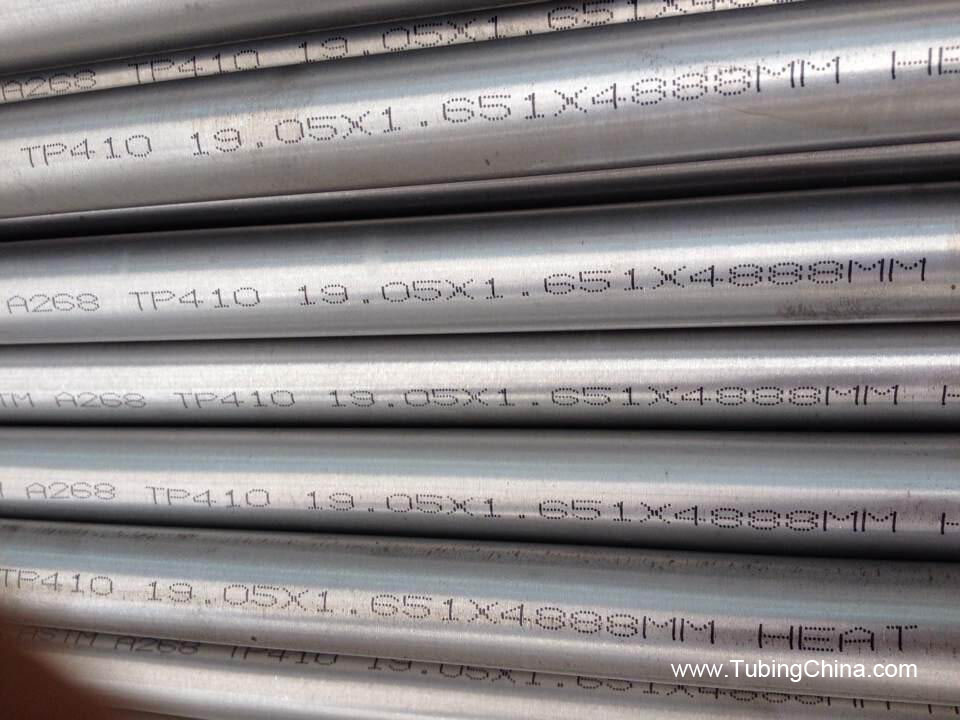410 420 420S45 Stainless Steel Heat Treatment Quenching
410 420 420S45 quenching and the main purpose is to obtain martensite. Due to their heated to a temperature above Ac3 range of fully dissolve the alloy carbide, carbon and chromium are more uniform austenite, then cooled down to the appropriate speed, ultimately martensite.
410 420 420S45 Steel Quenching
martensitic stainless steel with high chromium content for improved Ac3 transformation point, because of the presence of a large number of alloy carbides, the organization uneven distribution of carbon and chromium, and its diffusion rate in the heating process slowly, so as to fully dissolve carbide, martensite by uniform components, such steel quenching temperature higher than the carbon steel and alloy steel, raising an appropriate extension of quenching temperature and holding time.
Such poor thermal conductivity of steel, especially at lower temperatures, the thermal conductivity even worse, to prevent cracks during the heating process, to ensure that small temperature difference between inside and outside parts, should control the heating in the quenching speed, or the first warm-up. According to experience, at 750 °C before heating rate should be less than 80 °C / h.
Quenching temperature on the organization of ferrite content have an impact. In the composition is constant, the heating temperature in the range 950 ~ 1100 °C, the ferrite volume remained in the lower range. As the heating temperature, the ferrite content increased significantly. Therefore, the recommended standard in the material 1Cr13 steel quenching temperature is 950 ~ 1000 °C, but in actual production, to ensure sufficient carbon and alloying elements dissolved, often taking quenching temperature in 1000 ~ 1050 °C. Higher heating temperature will cause the organization to increase the ferrite and grain growth.
410 420 420S45 steel, carbon content because of their different original structure differences, so their quenching temperature is slightly different.
Lower the carbon content of steel 410, heated to quenching temperature, still in the austenite and ferrite edge of two-phase region, the organization will contain a certain amount of ferrite. After quenching, this part of undissolved ferrite retained in the tissues of hardened steel. The amount of ferrite, the first related with the carbon content, in addition, the content of chromium and molybdenum, silicon remaining volume will have an impact. Hardened steel in the presence of ferrite, hardness, mechanical properties, especially impact toughness will have adverse effects, therefore, higher in the mechanical performance requirements of the parts used 410 steel, should be made of special composition control conditions. Production practice, found that although 410 stainless steel components are qualified in the standard range, but the actual carbon content of less than 0.11%, chromium content in the upper limit (> 13% of the organization ferrite content can reach 15% to 20 %, while in fact control the carbon content from 0.12% to 0.15%, chromium content in the next limit (<12%), the organization of the ferrite can be less than 5%.
410 420 420S45 steel relative to steel, it has a higher carbon content, under normal circumstances, the organization would not exist after quenching the ferrite, the determination of quenching temperature of steel in the main is to ensure full dissolution of the carbide in the austenite to ensure quenching and tempering to get a good mechanical properties and corrosion resistance. 420 choice of steel quenching temperature 980 ~ 1000 °C and full insulation to the actual production of some of the heating temperature increased slightly, 420 quenching temperature is usually taken 1000 ~ 1030 °C, The 420 carbide steel ones, the actual production of quenching temperature can get 1020 ~ 1050 °C. Higher quenching temperature should not be used, because higher temperatures will cause coarse austenite grain size, have an adverse effect. Quenching temperature can also cause quenching hardness greater decline, mainly due to the excessive alloying elements and carbon dissolved, increase the stability of austenite, quenching there will be more retained austenite reasons.
 410 420 420S45 steel quenching
410 420 420S45 steel, due to the role of the higher chromium content, the more stable austenite, isothermal transformation curve to the right. During the cooling process is not easy pearlite and bainite transformation, reducing the critical cooling rate. In the lower cooling rate conditions, the martensitic transformation can be carried out to obtain martensite by air cooling or oil cooling can be high quenching hardness. But the oil cooling than air cooling of the steel quenched and tempered hardness and strength in the same circumstances, have a better ductility and toughness. Therefore, in the actual production, for parts or sections of a larger size on the mechanical performance, particularly higher ductility and toughness requirements of the parts, preferably oil cooling, for small parts and complex shape, easy to produce parts quenching crack with the use of air cooling.
410 420 420S45 steel, the critical point (approximate) in Table 1.
Table 1 410 420 420S45 steel critical point (approx.) (°C)
Ac1 Ac3 Ar3 Ar1 Ms
410 730 850 820 700 340
420 820 950 - 780 320
420s45 820 - - 780 240
Steel Metal Glossary
Passivation of Stainless Steels
The Heat Treatment of Steel
Heat Treatment of Metals Review
Heat Treating Terms and Definitions
Metals - Material Definitions and Terms
Heat Treating Stainless Steel | Heat treatment Stainless Steel
The Technic of Metals Heat Treatment-the heating,the heat preservation,the cool
|
